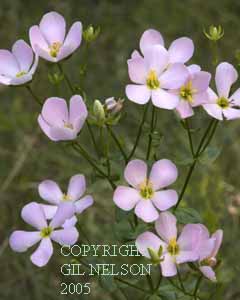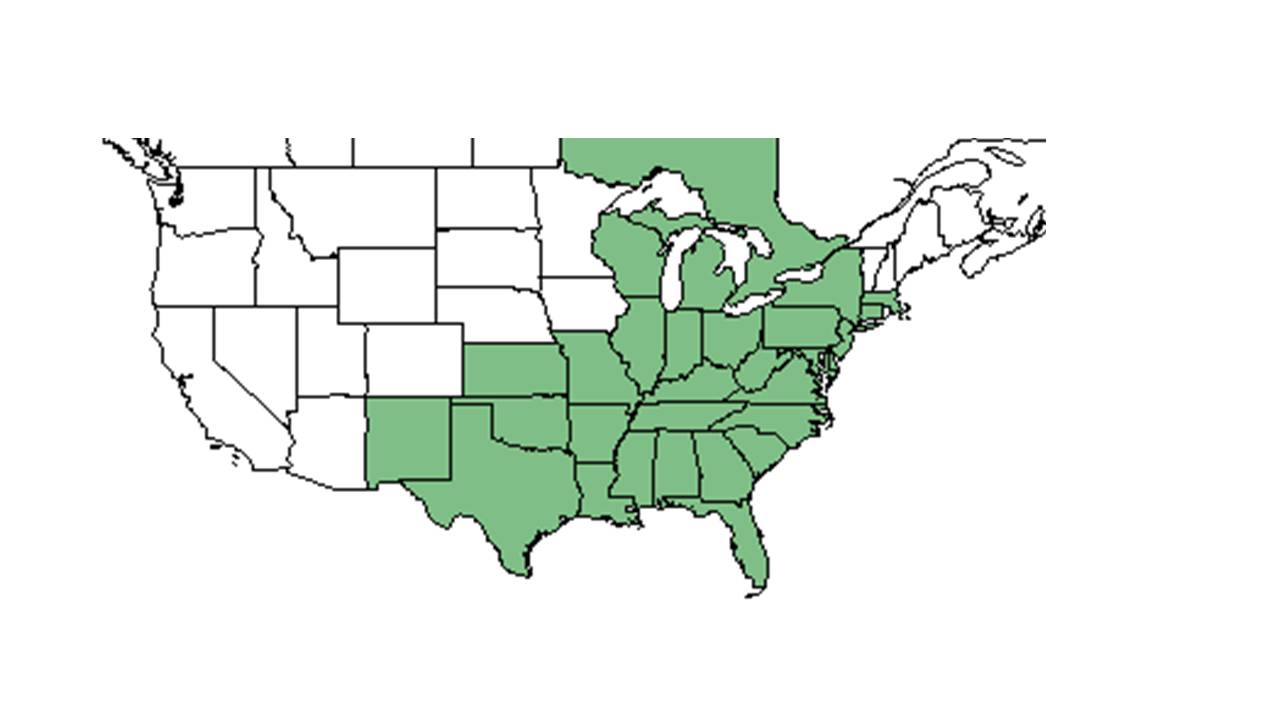Difference between revisions of "Sabatia angularis"
HaleighJoM (talk | contribs) (→Ecology) |
|||
| (6 intermediate revisions by 3 users not shown) | |||
| Line 22: | Line 22: | ||
==Description== | ==Description== | ||
<!-- Basic life history facts such as annual/perrenial, monoecious/dioecious, root morphology, seed type, etc. --> | <!-- Basic life history facts such as annual/perrenial, monoecious/dioecious, root morphology, seed type, etc. --> | ||
| − | "Glabrous, perennial or annual herbs with erect or ascending stems. Leaves opposite, entire, sessile. Inflorescence terminal, cymose. Calyx 5-13 parted, lobes united at bae, those of first flowers longest, smaller on later flowers; corolla rotate white or pink with yellow eye, lobes 5-13, tube becoming membranous and persistent around the capsule. Capsule ovoid to ellipsoid; seeds small, alveolate." <ref name="Radford et al 1964">Radford, Albert E., Harry E. Ahles, and C. Ritchie Bell. Manual of the Vascular Flora of the Carolinas. 1964, 1968. The University of North Carolina Press. 838. Print.</ref> | + | "Glabrous, perennial or annual herbs with erect or ascending stems. Leaves opposite, entire, sessile. Inflorescence terminal, cymose. Calyx 5-13 parted, lobes united at bae, those of first flowers longest, smaller on later flowers; corolla rotate white or pink with yellow eye, lobes 5-13, tube becoming membranous and persistent around the capsule. Capsule ovoid to ellipsoid; seeds small, alveolate."<ref name="Radford et al 1964">Radford, Albert E., Harry E. Ahles, and C. Ritchie Bell. Manual of the Vascular Flora of the Carolinas. 1964, 1968. The University of North Carolina Press. 838. Print.</ref> |
| − | "Annual, rhizomes absent. Stems freely branched, quadrangular, usually winged, 2-8 dm tall. Basal leaves absent or present at anthesis; stems leaves ovate to ovate-lanceolate, 1.5-5 cm long, 1-4 cm wide, acute. Inflorescence paniculate, 1-2.5 cm broad, to 3.5 dm long, branches opposite. Calyx lobes 5, linear to narrow lanceolate, 0.7-1.5 cm long; corolla lobes pink, rarely white, oblanceolate, 1.5-2cm long, 0.6-1 cm wide; filaments 3-5 mm long; stigmas and style 4-6 mm long. Capsule ellipsoid, 6-10 mm long, angles not winged; seeds blackish brown, 0.4-0.5 mm long." <ref name="Radford et al 1964"/> | + | "Annual, rhizomes absent. Stems freely branched, quadrangular, usually winged, 2-8 dm tall. Basal leaves absent or present at anthesis; stems leaves ovate to ovate-lanceolate, 1.5-5 cm long, 1-4 cm wide, acute. Inflorescence paniculate, 1-2.5 cm broad, to 3.5 dm long, branches opposite. Calyx lobes 5, linear to narrow lanceolate, 0.7-1.5 cm long; corolla lobes pink, rarely white, oblanceolate, 1.5-2cm long, 0.6-1 cm wide; filaments 3-5 mm long; stigmas and style 4-6 mm long. Capsule ellipsoid, 6-10 mm long, angles not winged; seeds blackish brown, 0.4-0.5 mm long."<ref name="Radford et al 1964"/> |
==Distribution== | ==Distribution== | ||
| − | It is found in upland forests, forest edges, glades, and meadows. It is mostly an upland species, but sometimes will be seen along the edges of upland streams. <ref name="Nelson 2006">Nelson, Gil. Atlantic Coastal Plain Wildflowers: A Field Guide to the Wildflowers of the Coastal Regions of Virginia, North Carolina, South Carolina, Georgia, and Northeastern Florida. Guilford, CT: FalconGuide, 2006. 86. Print.</ref> | + | It is found in upland forests, forest edges, glades, and meadows. It is mostly an upland species, but sometimes will be seen along the edges of upland streams.<ref name="Nelson 2006">Nelson, Gil. Atlantic Coastal Plain Wildflowers: A Field Guide to the Wildflowers of the Coastal Regions of Virginia, North Carolina, South Carolina, Georgia, and Northeastern Florida. Guilford, CT: FalconGuide, 2006. 86. Print.</ref> |
==Ecology== | ==Ecology== | ||
===Habitat=== <!--Natural communities, human disturbed habitats, topography, hydrology, soils, light, fire regime requirements for removal of competition, etc.--> | ===Habitat=== <!--Natural communities, human disturbed habitats, topography, hydrology, soils, light, fire regime requirements for removal of competition, etc.--> | ||
| − | In the Coastal Plain in Florida and Georgia, ''S. angularis'' can be found in floodplain forests, hardwoods, annually burned upland pine woodlands, annually burned savannas, upland pines, and limestone glades. Associated species include ''Schoenus nigricans, Rhynchospora divergens'', and ''Juniperus.'' <ref name="FSU Herbarium">Florida State University Robert K. Godfrey Herbarium database. URL: [http://herbarium.bio.fsu.edu http://herbarium.bio.fsu.edu]. Last accessed: July 2015. Collectors: Robert K. Godfrey, Roy Komarek, R. A. Norris, Richard R. Clinebell II, J. M. Kane, Loran C. Anderson. States and Counties: Florida: Calhoun, Jackson, Leon. Georgia: Grady, Thomas. Compiled by Tall Timbers Research Station and Land Conservancy.</ref> | + | In the Coastal Plain in Florida and Georgia, ''S. angularis'' can be found in floodplain forests, hardwoods, annually burned upland pine woodlands, annually burned savannas, upland pines, and limestone glades.<ref name="FSU Herbarium"></ref> |
| + | |||
| + | Associated species include ''Schoenus nigricans, Rhynchospora divergens'', and ''Juniperus.''<ref name="FSU Herbarium">Florida State University Robert K. Godfrey Herbarium database. URL: [http://herbarium.bio.fsu.edu http://herbarium.bio.fsu.edu]. Last accessed: July 2015. Collectors: Robert K. Godfrey, Roy Komarek, R. A. Norris, Richard R. Clinebell II, J. M. Kane, Loran C. Anderson. States and Counties: Florida: Calhoun, Jackson, Leon. Georgia: Grady, Thomas. Compiled by Tall Timbers Research Station and Land Conservancy.</ref> | ||
===Phenology=== <!--Timing off flowering, fruiting, seed dispersal, and environmental triggers. Cite PanFlora website if appropriate: http://www.gilnelson.com/PanFlora/ --> | ===Phenology=== <!--Timing off flowering, fruiting, seed dispersal, and environmental triggers. Cite PanFlora website if appropriate: http://www.gilnelson.com/PanFlora/ --> | ||
| Line 39: | Line 41: | ||
<!--===Fire ecology===--> <!--Fire tolerance, fire dependence, adaptive fire responses--> | <!--===Fire ecology===--> <!--Fire tolerance, fire dependence, adaptive fire responses--> | ||
<!--===Pollination===--> | <!--===Pollination===--> | ||
| − | <!--=== | + | <!--===Herbivory and toxicology===<!--Common herbivores, granivory, insect hosting, poisonous chemicals, allelopathy, etc--> |
<!--===Diseases and parasites===--> | <!--===Diseases and parasites===--> | ||
| − | ==Conservation and | + | ==Conservation, cultivation, and restoration== |
| − | == | + | |
| + | ==Cultural use== | ||
==Photo Gallery== | ==Photo Gallery== | ||
<gallery widths=180px> | <gallery widths=180px> | ||
</gallery> | </gallery> | ||
==References and notes== | ==References and notes== | ||
Latest revision as of 11:43, 15 July 2022
| Sabatia angularis | |
|---|---|

| |
| Photo taken by Gil Nelson | |
| Scientific classification | |
| Kingdom: | Plantae |
| Division: | Magnoliophyta – Flowering plants |
| Class: | Magnoliopsida – Dicotyledons |
| Order: | Gentianales |
| Family: | Gentianaceae |
| Genus: | Sabatia |
| Species: | S. angularis |
| Binomial name | |
| Sabatia angularis (L.) Pursh | |

| |
| Natural range of Sabatia angularis from USDA NRCS Plants Database. | |
Common names: Rosepink[1], Bitter-bloom, Common marshpink
Contents
Taxonomic notes
Description
"Glabrous, perennial or annual herbs with erect or ascending stems. Leaves opposite, entire, sessile. Inflorescence terminal, cymose. Calyx 5-13 parted, lobes united at bae, those of first flowers longest, smaller on later flowers; corolla rotate white or pink with yellow eye, lobes 5-13, tube becoming membranous and persistent around the capsule. Capsule ovoid to ellipsoid; seeds small, alveolate."[2]
"Annual, rhizomes absent. Stems freely branched, quadrangular, usually winged, 2-8 dm tall. Basal leaves absent or present at anthesis; stems leaves ovate to ovate-lanceolate, 1.5-5 cm long, 1-4 cm wide, acute. Inflorescence paniculate, 1-2.5 cm broad, to 3.5 dm long, branches opposite. Calyx lobes 5, linear to narrow lanceolate, 0.7-1.5 cm long; corolla lobes pink, rarely white, oblanceolate, 1.5-2cm long, 0.6-1 cm wide; filaments 3-5 mm long; stigmas and style 4-6 mm long. Capsule ellipsoid, 6-10 mm long, angles not winged; seeds blackish brown, 0.4-0.5 mm long."[2]
Distribution
It is found in upland forests, forest edges, glades, and meadows. It is mostly an upland species, but sometimes will be seen along the edges of upland streams.[1]
Ecology
Habitat
In the Coastal Plain in Florida and Georgia, S. angularis can be found in floodplain forests, hardwoods, annually burned upland pine woodlands, annually burned savannas, upland pines, and limestone glades.[3]
Associated species include Schoenus nigricans, Rhynchospora divergens, and Juniperus.[3]
Phenology
S. angularis has been observed to flower May to September.[1][4]
Conservation, cultivation, and restoration
Cultural use
Photo Gallery
References and notes
- ↑ 1.0 1.1 1.2 Nelson, Gil. Atlantic Coastal Plain Wildflowers: A Field Guide to the Wildflowers of the Coastal Regions of Virginia, North Carolina, South Carolina, Georgia, and Northeastern Florida. Guilford, CT: FalconGuide, 2006. 86. Print.
- ↑ 2.0 2.1 Radford, Albert E., Harry E. Ahles, and C. Ritchie Bell. Manual of the Vascular Flora of the Carolinas. 1964, 1968. The University of North Carolina Press. 838. Print.
- ↑ 3.0 3.1 Florida State University Robert K. Godfrey Herbarium database. URL: http://herbarium.bio.fsu.edu. Last accessed: July 2015. Collectors: Robert K. Godfrey, Roy Komarek, R. A. Norris, Richard R. Clinebell II, J. M. Kane, Loran C. Anderson. States and Counties: Florida: Calhoun, Jackson, Leon. Georgia: Grady, Thomas. Compiled by Tall Timbers Research Station and Land Conservancy.
- ↑ Nelson, G. PanFlora: Plant data for the eastern United States with emphasis on the Southeastern Coastal Plains, Florida, and the Florida Panhandle. www.gilnelson.com/PanFlora/ Accessed: 13 DEC 2016